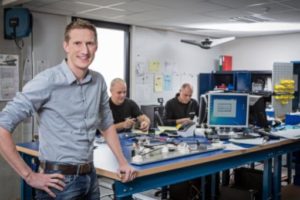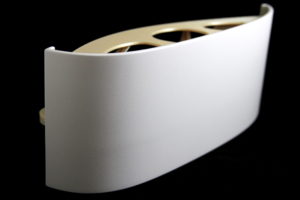Interest in the on-site and on-demand possibilities of creating parts and components with additive manufacturing (AM) and 3D printing is becoming widespread across the aerospace sector – from OEMs to MRO and the emerging urban air mobility (UAM) sector.
Materialise, which has its headquarters in Leuven, Belgium, was founded in 1990 with the goal of maximising the potential of 3D printing. The company has since created a range of software solutions and 3D printing services across a number of industries, including healthcare, automotive, aerospace and consumer goods.
Materialise has branches worldwide, the largest group of software developers in the industry and one of the largest 3D printing facilities in the world. It manufactures 700 part series per year for aerospace customers, from OEMs to MROs and supplier tiers including an estimated 26,000 parts per year for the Airbus A350 system alone.
The company is currently the only supplier to offer manufacturing services in two 3D printing technologies approved by Airbus for flight-ready parts, becoming Airbus’s first manufacturer for the Selective Laser Sintering (SLS) technology in May 2021.
Materialise announced a partnership with Proponent to transform the aerospace aftermarket supply chains with 3D printing at MRO Europe in Amsterdam last month. Proponent, which is headquartered in California, is a leading independent distributor of aircraft parts, providing traditional distribution services to airlines, MROs and OEMs, as well as inventory management solutions. The company delivers 54 million parts per year to more than 6,000 aerospace customers in more than 100 countries.
The agreement will see the companies exploring ways to help aerospace OEMs access the benefits of 3D printing, including a digital supply chain which enables on-demand manufacturing. So far, 3D printing has been the domain of specialist engineering departments in aerospace companies. The new agreement will bring the technology into the procurement domain, making it increasingly accessible for MROs to source 3D-printed parts for applications which span cabin interiors, engines, airframe and cockpits.
FINN’s Digital Editor Katherine Simmons talked to Erik de Zeeuw, Aerospace Market Manager of Materialise, about how aerospace companies are currently using 3D printing and additive manufacturing (AM) and the greater potential these technologies can offer.
Your company has been in additive manufacturing since the early days of the technology – can you outline the developments within flight-ready 3D printed parts since Materialise was founded in 1990?
EdZ: “In the early days, we started with rapid prototyping, so making prototypes for new developments which were going to be conventionally manufactured. Prototyping was an early benefit of 3D printing technology because it’s a quick way to validate designs. It is still a large part of our activity, but over the years the technology matured and today has recognised benefits as a manufacturing technique for end use parts.”
“Around 2014/15 we reached a pivotal point: we were approached by Airbus to become a qualified supplier for them. We were also delivering our first parts to other OEMs and MRO companies and received two qualifications – EN9100 and EASA 21.G – which allowed us to produce certified flying parts. Within aerospace, the series are smaller and the benefits of lightweight AM are very promising, so this is an industry with growing interest within this field.”
Supply chain issues are a hot topic across the UK and globally at the moment. What part does additive manufacturing play in alleviating these problems?
 EdZ: “Mostly additive boosts accessibility and local supply. AM itself didn’t suffer significantly from general supply chain shortages during the pandemic; at this moment, additive only represents a small part of the manufacturing market and is used with specific material grades. On the other hand, AM did become a solution for other industries to alleviate shortages: it’s an alternative way to produce specific parts on demand and locally, where traditional manufacturing and overseas suppliers were unable to deliver owing to the COVID crisis..”
EdZ: “Mostly additive boosts accessibility and local supply. AM itself didn’t suffer significantly from general supply chain shortages during the pandemic; at this moment, additive only represents a small part of the manufacturing market and is used with specific material grades. On the other hand, AM did become a solution for other industries to alleviate shortages: it’s an alternative way to produce specific parts on demand and locally, where traditional manufacturing and overseas suppliers were unable to deliver owing to the COVID crisis..”
“There have been several hypes around the technology in the past, especially around 2012, when it was going to ‘beat everything’ which didn’t prove true. Now, there’s a momentum again which is a better reflection of how the technology, within its limits, can be used.”
“We call it a ‘slow revolution.’ The market is still growing significantly, but it will never replace everything that’s being manufactured. On the other hand it has taken over complete niches, such as hearing aids, where it has completely replaced older manufacturing technologies. We will see it becoming more and more common, that’s for sure.”
“Players in every industry have been looking at what additive can do for them, they can see the potential. AM has been maturing rapidly in the last few years for end use parts, thanks to improvements in process control and stability.”
Can you give some examples of the most popular aerospace parts manufactured?
EdZ: “There are largely two categories: on one hand, you have ‘superhero’ applications, very difficult to realise and get certified but these are the ones that get all the media attention. A popular example of this was made by General Electric. They saw the potential of using AM to manufacture complex metal parts in the engine to reduce weight and to combine parts. They have been putting a huge amount of resources in this product, but it has been very successful in the sense that it has it showcased the benefits of AM in reducing weight, reducing components and in adding functionality, all in an application that can safely fly.”
“The other category is the ‘unsung’ heroes. It’s possible now to make low criticality and non-critical parts using additive manufacturing. And this, you see almost everywhere in the plane, especially in the cabin interior, for instance exit signs or pen holders. The majority of the parts that we produce are in this field. Here AM doesn’t really offer design benefits – the designs are essentially the same as in traditional manufacturing – but it does offer supply chain advantages. In the aftermarket, for example, airlines typically need only a few of each part, but conventional manufacturing would force them into large minimum order quantities which they then have to stock. AM enables series sizes starting from one. These kinds of low-criticality applications are also a good way for aerospace companies to get used to the technology and then scale up step by step through to higher criticality products.”
What are the particular benefits of 3D parts for MRO companies in particular?

EdZ: “When people think of the typical benefits of AM, they typically think of the design freedom and the complexity of the products. But there are also a lot of advantages in the supply chain area, so the accessibility of 3D printing, the quick turnarounds for getting a part printed, also in aerospace companies where there’s more complexity around certification.”
“You don’t need to go to the effort of tooling and, especially in the context of MROs, which are faced with end of life products but where they still need to supply several aircraft, you don’t have minimum order quantities in 3D printing. The benefits really speak to the specific needs of MRO companies.”
Can you also explain how the technology can aid development of the urban air mobility/UAV sectors?
EdZ: “There is a race to the sky with a huge number of projects in this segment, all looking to start aircraft production or achieve certification in the next two to five years. There is a massive ongoing product development with a need for iterations, prototypes, bridge manufacturing, all the things that AM could supply. That’s the case with the Lift aircraft where we used 3D printing to iterate an eVTOL aircraft from a sheet of paper to a manned flight for our client in just over a year.” [Read more about the project here ]
“Urban air mobility aircraft typically use electric propulsion, which means they have to be as lightweight as possible to get the maximum amount out of the batteries. Lightweight almost by default means complex: think latticed interiors and topology-optimized parts, as opposed to a solid block. Assuring part properties, testing and inspection in this environment is also correspondingly complex. So it’s understandable why regulators are legitimately cautious. At the same time the benefits of AM in this application are obvious. You can see the potential of AM being applied in that market, it’s definitely coming in the future.”
Looking forward for the rest of the decade, what changes or issues do you expect to see within additive manufacturing?
EdZ: “Within aerospace, it’s not easy to create and certify a design. Additive manufacturing is a highly sensitive process – there are a lot of factors which influence the quality of a product and all these factors need to be controlled. The knowledge is still in its mid-to-early days. We know what we need to do but it’s very intensive, and you have to be very rigorous to get it right.”
“What companies and regulatory authorities are looking for is enhanced process control. To have an output that’s very stable and predictable still requires a lot of development. This is an issue for companies that want to apply 3D printing but the whole industry is focused and working on that specifically for aerospace. This is something in the next decade which will evolve and, step-by-step, will mature. At Materialise we’ve already taken steps to standardize data generation and open up our data lake to our aerospace partners to help in their qualification efforts.”
“On the materials side, so far the industry has been making use of materials that are flight worthy but are mainly designed by the AM industry. Material development for 3D printing is rather complex, but there are more materials that would fit with specific aerospace needs: high performance polymers, more specific metal alloys, which are in development.”
“It would be quite intensive to replace existing parts with 3D printing, but I expect, when you get to aircraft development, it will be considered more and more. Our ultimate hope is that AM will be considered as a technology that will be used whenever you require a complex part or part in a small series so that it’s not something special any more. However, the workforce will need to be trained, design engineers and so on, will have to understand how it works and what it can do.”
Can you outline the measures that you’re taking to raise the sustainability of additive manufacturing at Materialise?
“The messaging around AM is that you just print what you need and, in that sense, AM is a sustainable technology. But the real message is ‘how can we make AM more sustainable?’ Along with other 3D printing companies, we are very resource intensive with speciality materials which are not free from impact.”
“We have defined sustainability as a key strategic component and adopted several methodologies to address that. We have increased our yearly reporting on sustainability, according to the UN Global Compact, adopted several environmental management methodologies such as ISO 14000 and from that reactive approach we have evolved to a proactive approach.”
“We have committed to science-based targets to cut half our emissions by 2025. These are actions we are taking at different levels so it’s embedded in our management systems, structured, and is quite ambitious. Recent achievements have been a circularity improvement in our most used polymer material, a new air travel policy which forbids flights for distances shorter than 400 kilometres, we are also in the process of powering all our offices worldwide with green energy by the end of 2022. There’s a variety of actions focused on a big global plan.”
“It’s [Environmental reporting] not something that we experience as a pressure from our aerospace customers at this moment but its coming more from our investors, within certain verticals, from our consumers, and not least from our own workforce.”
